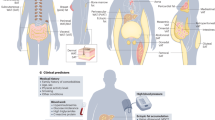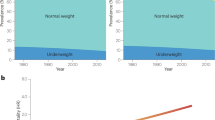Abstract
Obesity is not synonymous with insulin resistance. Why some but not all individuals develop insulin resistance with weight excess is not clear, but a number of plausible hypotheses with ample support now exist. This article reviews regional fat distribution, inflammation, lipotoxicity/ectopic fat and impaired adipogenesis as leading theories as to why excess body weight has the potential to promote insulin resistance.
This is a preview of subscription content, access via your institution
Access options
Subscribe to this journal
We are sorry, but there is no personal subscription option available for your country.
Buy this article
- Purchase on Springer Link
- Instant access to full article PDF
Prices may be subject to local taxes which are calculated during checkout
Similar content being viewed by others
References
Flegal KM, Carroll MD, Ogden CL, Curtin LR . Prevalence and trends in obesity among US adults, 1999–2008. JAMA 2010; 202: 235–241.
Finklestein EA, Trogdon JG, Cohen JW, Dietz W . Annual medical spending attributable to obesity: payer-and service-specific estimates. Health Aff 2009; 28: w822–w831.
McLaughlin T, Allison G, Abbasi F, Lamendola C, Reaven G . Prevalence of insulin resistance and associated cardiovascular risk factors among normal, overweight, and obese individuals. Metabolism 2004; 53: 495–499.
Yeni-Komshian H, Caratoni M, Abbasi F, Reaven GM . Relationship between several surrogate estimates of insulin resistance and quantification of insulin-mediated glucose disposal in 480 healthy nondiabetic volunteers. Diabetes Care 2000; 23: 171–173.
McLaughlin T, Abbasi F, Lamendola C, Reaven G . Heterogeneity in prevalence of risk factors for cardiovascular disease and type 2 diabetes in obese individuals: impact of differences in insulin sensitivity. Archives Int Med 2007; 167: 642–648.
Yip J, Gacchini FS, Reaven GM . Resistance to insulin-mediated glucose disposal as a predictor of cardiovascular disease. J Clin Endocrinol Metab 1998; 83: 2773–2777.
Facchini FS, Hua N, Abbasi F, Reaven GM . Insulin resistance as a predictor of age-related-diseases. J Clin Endocrinol Metab 2001; 86: 3574–3578.
Zavaroni I, Bonini L, Gasparini P, Barilli AL, Zuccarelli A, Dall’Aglio E et al. Hyperinsulinemia in a normal population as a predictor of non-insulin-dependent diabetes mellitus, hypertension, and coronary heart disease: the Barilla factory revisited. Metabolism 1999; 48: 989–994.
McLaughlin T, Abbasi F, Lamendola C, Liang L, Reaven G, Schaaf P et al. Differentiation between obesity and insulin resistance in the association with C-reactive protein. Circulation 2002; 106: 2908–2912.
McLaughlin T, Stuhlinger M, Lamendola C, Abbasi F, Reaven GM, Tsao PS . Plasma asymmetric dimethylarginine concentrations are elevated in insulin-resistant women and fall with weight loss. J Clin Endocrinol Metab 2006; 91: 1896–1900.
McLaughlin T, Abbasi F, Kim HS, Lamendola C, Schaaf P, Reaven G . Relationship between insulin resistance, weight loss and coronary heart disease risk in obese healthy women. Metabolism 2001; 50: 795–800.
Ohlson LO, Larsson B, Svardsudd K, Welin L, Eriksson H, Wilhelmsen L et al. The influence of body fat distribution on the incidence of diabetes mellitus. 13.5 years of follow-up of the participants in the study of men born in 1913. Diabetes 1985; 34: 1055–1058.
Lapidus L, Bengtsson C, Larsson B, Pennert K, Rybo E, Sjostrom L . Distribution of adipose tissue and risk of cardiovascular disease and death: a 12 year follow up of participants in the population study of women in Gothenburg, Sweden. Br Med J 1984; 289: 1257–1261.
McLaughlin T, Lamendola C, Liu A, Abbasi F . Preferential fat deposition in subcutaneous versus visceral depots is associated with insulin sensitivity. J Clin Endocrinol Metab 2011; 96: E1756–E1760.
Brochu M, Starling RD, Tchernof A, Matthews DE, Garcia-Rubi EET . Visceral adipose tissue is an independent correlate of glucose disposal in older obese postmenopausal women. J Clin Endocrinol Metab 2000; 86: 5366–5371.
Ross R, Aru J, Freeman J, Hudson R, Janssen I . Abdominal adiposity and insulin resistance in obese men. Am J Physiol 2002; 282: E657–E663.
Ross R, Freeman J, Hudson R, Janssen I . Abdominal obesity, muscle composition, and insulin resistance in premenopausal women. J Clin Endocrinol Metab 2002; 87: 5044–5051.
Goodpaster BH, Thaete FL, Simoneau JA, Kelley DE . Subcutaneous abdominal fat and thigh muscle composition predict insulin sensitivity independently of visceral fat. Diabetes 1997; 46: 1579–1585.
Abate N, Garg A, Peshock RM, Stray-Gundersen J, Grundy SM . Relationships of generalized and regional adiposity to insulin sensitivity in men. J Clin Invest 1995; 96: 88–98.
Porter SA, Massaro JM, Hoffmann U, Vasan RS, O’Donnel CJ, Fox CS . Abdominal subcutaneous adipose tissue: a protective fat depot? Diabetes Care 2009; 32: 1068–1075.
Liu A, McLaughlin T, Liu T, Sherman A, Yee G, Abbasi F et al. Differential intra-abdominal adipose tissue profiling in obese, insulin-resistant women. Obes Surg 2009; 19: 1564–1573.
Bolinder J, Kager L, Ostman J, Arner P . Differences at the receptor and postreceptor levels between human omental and subcutaneous adipose tissue in the action of insulin on lipolysis. Diabetes 1983; 32: 117–123.
Fabbrini E, Tamboli RA, Magkos F, Marks-Shulman PA, Eckhauser AW, Richards WO et al. Surgical removal of omental fat does not improve insulin sensitivity and cardiovascular risk factors in obese adults. Gastroenterology 2010; 139: 448–455.
Pradhan AD, Manson JE, Rifai N, Buring JE, Ridker PM et al. C-reactive protein, interleukin 6, and risk of developing type 2 diabetes mellitus. JAMA 2001; 286: 327–334.
Cinti S, Mitchell G, Barbatelli G, Murano I, Ceresi E, Faloia E et al. Adipocyte death defines macrophage localization and function in adipose tissue of obese mice and humans. J Lipid Res 2005; 46: 2347–2355.
Weisberg SP, McCann D, Desai M, Rosenbaum M, Leibel RL, Ferrante Jr AW, Weisberg S et al. Obesity is associated with macrophage accumulation in adipose tissue. J Clin Invest 2003; 112: 1796–1808.
Yuan M, Konstantopoulos N, Lee J, Hansen L, Li ZW, Karin M et al. Reversal of obesity- and diet-induced insulin resistance with salicylates or targeted disruption of Ikkbeta. Science 2001; 293: 1673–1677.
Kanda H, Tateya S, Tamori Y et al. MCP-1 contributes to macrophage infiltration into adipose tissue, insulin resistance, and hepatic steatosis in obesity. J Clin Invest 2006; 116: 1494–1505.
Weisberg SP, Hunter D, Huber R, Lemieux J, Slaymaker S, Vaddi K et al. CCR2 modulates inflammatory and metabolic effects of high-fat feeding. J Clin Invest 2006; 116: 115–124.
McLaughlin T, Deng A, Gonzales O, Aillaud M, Yee G, Lamendola C et al. Comparison of inflammatory markers in subcutaneous adipose tissue obtained from equally obese insulin resistant and insulin sensitive women. Diabetologia 2008; 51: 2303–2308.
Goldfine AB, Fonseca V, Jablonski KA, Pyle L, Staten MA, Shoelson SE, TINSAL-T2D (Targeting Inflammation Using Salsalate in Type 2 Diabetes) Study Team. The effects of salsalate on glycemic control in patients with type 2 diabetes: a randomized trial. Ann Intern Med 2010; 152: 346–357.
Koska J, Ortega E, Bunt JC, Gasser A, Impson J, Hanson RL et al. The effect of salsalate on insulin action and glucose tolerance in obese non-diabetic patients: results of a randomised double-blind placebo-controlled study. Diabetologia 2009; 52: 385–393.
McLaughlin T, Yee G, Glassford A, Lamendola C . Use of a two-stage insulin suppression test to assess the relationship between insulin-suppression of lipolysis and insulin-mediated glucose uptake in overweight/obese, nondiabetic women. Metabolism 2011; 60: 1741–1747.
Samuel VT, Petersen KF, Shulman GI . Lipid-induced insulin resistance: unravelling the mechanism. Lancet 2010; 375: 2267–2277.
Boden G . Obesity, insulin resistance and free fatty acids. Curr Opin Endocrinol Diabetes Obes 2001; 18: 139–143.
McLaughlin T, Abbasi F, Lamendola C, Kim H, Reaven GM . Metabolic changes following sibutramine-assisted weight loss in obese individuals: role of free fatty acids in the insulin resistance of obesity. Metabolism 2001; 50: 819–824.
Miyazaki Y, Glass L, Triplitt C, Matsuda M, Cusi K, Mahankali A et al. Effect of rosiglitazone on glucose and non-esterified fatty acid metabolism in type II diabetic patients. Diabetologia 2001; 44: 2210–2219.
Bajaj M, Baig R, Suraamornkul S, Hardies LJ, Coletta DK, Cline GW et al. Effects of pioglitazone on intramyocellular fat metabolism in patients with type 2 diabetes mellitus. J Clin Endocrinol Metab 2010; 95: 1916–1923.
Spalding KL, Arner E, Westermark PO, Bernard S, Buchholz BA, Bergmann O et al. Dynamics of fat cell turnover in humans. Nature 2008; 453: 783–787.
Faust IM, Johnson PR, Stern JS, Hirsch J . Diet-induced adipocyte number increase in adult rats: a new model of obesity. Am J Physiol 1978; 4: E279–E286.
Kashiwagi A, Mott D, Bogardus C, Lilioja S, Reaven GM, Foley JE . The effects of short-term overfeeding on adipocyte metabolism in Pima Indians. Metabolism 1985; 34: 364–370.
McLaughlin T, Sherman A, Tsao P, Gonzalez O, Yee G et al. Enhanced proportion of small adipose cells in insulin-resistant vs insulin -sensitive obese individuals implicates impaired adipogenesis. Diabetologia 2007; 50: 1707–1715.
Yang X, Jansson P, Nagaev I, Jack MM, Carvalho E, Sunnerhagen KS et al. Evidence of impaired adipogenesis in insulin resistance. Biochem Biohys Res Commun 2004; 317: 1045–1051.
McLaughlin T, Deng A, Yee G, Lamendola C, Reaven G, Tsao P et al. Inflammation in subcutaneous adipose tissue: relationship to adipose cell size. Diabetologia 2010; 53: 369–377.
Kim JK, Gavrilova O, Chen Y, Reitman ML, Shulman GI . Mechanism of insulin resistance in AZIP/F-1 fatless mice. J Biol Chem 2000; 275: 8456–8460.
Petersen KF, Oral EA, Dufour S, Befroy D, Ariyan C, Yu C et al. Leptin reverses insulin resistance and hepatic steatosis in patients with severe lipodystrophy. J Clin Invest 2002; 109: 1345–1350.
McLaughlin T, Liu T, Yee G, Abbasi F, Lamendola C, Reaven G et al. Pioglitazone increases the proportion of small cells in human subcutaneous adipose tissue. Obesity 2010; 18: 926–931.
Acknowledgements
TM has received grant support from Amylin/Lilly. TM serves as an expert witness for diabetes cases. TM has also received grant support from National Institutes of Health/National Institute of Digestive Diseases and Diabetes, R01 DK080436, R01DK071309. The author acknowledges Dr Samuel W Cushman for his mentoring. Publication of this supplement was partially supported by Nutrilite Health Institute with an unrestricted educational contribution to Stanford Prevention Research Center.
Author information
Authors and Affiliations
Corresponding author
Ethics declarations
Competing interests
The author declares no conflict of interest.
Rights and permissions
About this article
Cite this article
McLaughlin, T. Metabolic heterogeneity of obesity: role of adipose tissue. Int J Obes Supp 2 (Suppl 1), S8–S10 (2012). https://doi.org/10.1038/ijosup.2012.3
Published:
Issue Date:
DOI: https://doi.org/10.1038/ijosup.2012.3
Keywords
This article is cited by
-
Accurate neuroimaging biomarkers to predict body mass index in adolescents: a longitudinal study
Brain Imaging and Behavior (2020)



